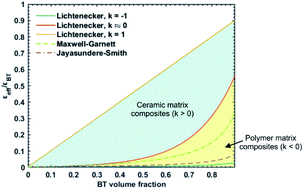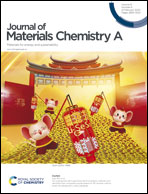Significantly enhanced permittivity and energy density in dielectric composites with aligned BaTiO3 lamellar structures†
Abstract
A significant improvement of permittivity and energy density will enable the miniaturization of dielectric capacitors and promote integration for applications in electrical power and defense systems. In this work, lamellar composite architectures are fabricated from aligned barium titanate (BaTiO3) in an epoxy resin using the freeze casting method. Due to the continuous coupling effect originating from the interconnected and highly oriented BaTiO3 particles, these composites exhibit an extremely high permittivity (εr = 1408) at 1 kHz, which is the highest value achieved in BaTiO3/polymer composites reported so far and fits well to the parallel mode of the mixing rule. A finite element model is used to investigate the local electric field distributions in the BaTiO3 lamellae under the applied electric field parallel and perpendicular to the freezing direction, respectively. A high ratio value of discharge energy density per electric field, Udis/E, ∼0.033, is achieved due to a high electric displacement of D = 15.11 μC cm−2 and a discharge energy density of Udis = 19.6 × 10−2 J cm−3 is achieved at a low electric field (6 kV mm−1). This work provides an effective strategy of designing a ceramic–polymer composite to realize high permittivity and energy density of capacitors for modern electrical and electronic industries.



 Please wait while we load your content...
Please wait while we load your content...